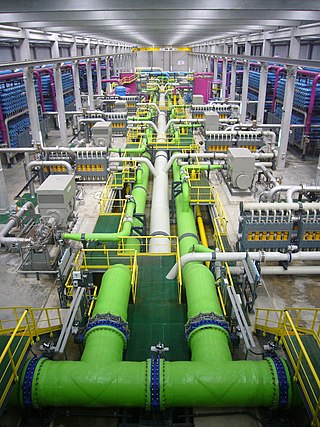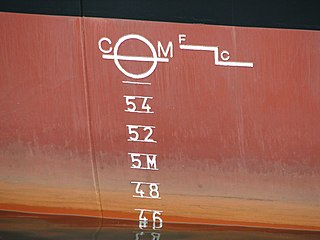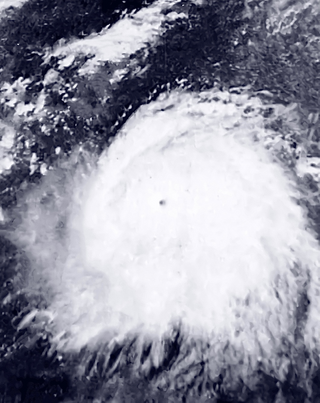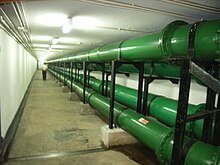
Brackish water, sometimes termed brack water, is water occurring in a natural environment that has more salinity than freshwater, but not as much as seawater. It may result from mixing seawater and fresh water together, as in estuaries, or it may occur in brackish fossil aquifers. The word comes from the Middle Dutch root brak. Certain human activities can produce brackish water, in particular civil engineering projects such as dikes and the flooding of coastal marshland to produce brackish water pools for freshwater prawn farming. Brackish water is also the primary waste product of the salinity gradient power process. Because brackish water is hostile to the growth of most terrestrial plant species, without appropriate management it is damaging to the environment.

Heating, ventilation, and air conditioning (HVAC) is the use of various technologies to control the temperature, humidity, and purity of the air in an enclosed space. Its goal is to provide thermal comfort and acceptable indoor air quality. HVAC system design is a subdiscipline of mechanical engineering, based on the principles of thermodynamics, fluid mechanics, and heat transfer. "Refrigeration" is sometimes added to the field's abbreviation as HVAC&R or HVACR, or "ventilation" is dropped, as in HACR.
Ocean thermal energy conversion (OTEC) is a renewable energy technology that harnesses the temperature difference between the warm surface waters of the ocean and the cold depths to run a heat engine to produce electricity. It is a unique form of clean energy generation that has the potential to provide a consistent and sustainable source of power. Although it has challenges to overcome, OTEC has the potential to provide a consistent and sustainable source of clean energy, particularly in tropical regions with access to deep ocean water.

Desalination is a process that takes away mineral components from saline water. More generally, desalination is the removal of salts and minerals from a target substance, as in soil desalination, which is an issue for agriculture. Saltwater is desalinated to produce water suitable for human consumption or irrigation. The by-product of the desalination process is brine. Desalination is used on many seagoing ships and submarines. Most of the modern interest in desalination is focused on cost-effective provision of fresh water for human use. Along with recycled wastewater, it is one of the few rainfall-independent water resources.
The ecology of Hong Kong is mostly affected by the results of climatic changes. Hong Kong's climate is seasonal due to alternating wind direction between winter and summer.

Continental Micronesia, Inc. (CMI) was a Guamanian company which was a wholly owned subsidiary of Continental Airlines. It operated daily flights to Honolulu, Hawaii, as well as international services to Asia, Micronesia and Australia from its base of operations at Antonio B. Won Pat International Airport on Guam, a U.S. territory in the western Pacific Ocean. During its final years, the airline, a Delaware corporation, was headquartered in the old terminal building at Won Pat International Airport in Tamuning, Guam.

Antonio B. Won Pat International Airport, also known as Guam International Airport, is an airport located in Tamuning and Barrigada, three miles (4.8 km) east of the capital city of Hagåtña in the United States territory of Guam. The airport is a hub for Asia Pacific Airlines and for United Airlines, serving as the latter's Pacific Ocean hub. It is also the home of the former Naval Air Station Agana, and is the only international airport in the territory. The airport is named after Antonio Borja Won Pat, the first delegate from Guam to the United States House of Representatives, and is operated by the A.B. Won Pat International Airport Authority, Guam, an agency of the Government of Guam.

Canadian Pacific Air Lines was a Canadian airline that operated from 1942 to 1987. It operated under the name CP Air from 1968 to 1986. Headquartered at Vancouver International Airport in Richmond, British Columbia, it served domestic Canadian as well as international routes until it was purchased by Pacific Western Airlines and absorbed into Canadian Airlines International.

The waterline is the line where the hull of a ship meets the surface of the water. Specifically, it is also the name of a special marking, also known as an international load line, Plimsoll line and water line, that indicates the draft of the ship and the legal limit to which a ship may be loaded for specific water types and temperatures in order to safely maintain buoyancy, particularly with regard to the hazard of waves that may arise. Varying water temperatures will affect a ship's draft, because warm water is less dense than cold water, providing less buoyancy. In the same way, fresh water is less dense than salinated or seawater with a similar lessening effect upon buoyancy.

The Excelsior was a four-star hotel located at 281 Gloucester Road, Causeway Bay, Hong Kong Island, in Hong Kong. It was owned and operated by Mandarin Oriental Hotel Group, a member of the Jardine Matheson Group, and served as the Mandarin Oriental Hotel Group's headquarters. The Noon-day Gun is located opposite the hotel. It closed on 31 March 2019 for demolition and replacement by an office tower.
Water supply and sanitation in Hong Kong is characterized by water import, reservoirs, and treatment infrastructure. Though multiple measures were made throughout its history, providing an adequate water supply for Hong Kong has met with numerous challenges because the region has few natural lakes and rivers, inadequate groundwater sources, a high population density, and extreme seasonable variations in rainfall. Thus nearly 80 percent of water demand is met by importing water from mainland China, based on a longstanding contract. In addition, freshwater demand is curtailed by the use of seawater for toilet flushing, using a separate distribution system. Hong Kong also uses reservoirs and water treatment plants to maintain its source of clean water.

Henderson Field is a public airport located on Sand Island in Midway Atoll, an unincorporated territory of the United States. The airport is used as an emergency diversion point for ETOPS operations. It is one of three airfields named after Major Lofton R. Henderson, together with Henderson Field on Midway's Eastern Island, and Henderson Field in the Solomon Islands. The airfield now provides access to Midway Atoll National Wildlife Refuge.

District cooling is the cooling equivalent of district heating. Working on broadly similar principles to district heating, district cooling delivers chilled water to buildings like offices and factories. In winter, the source for the cooling can often be seawater, so it is a cheaper resource than using electricity to run compressors for cooling. Alternatively, District Cooling can be provided by a Heat Sharing Network which enables each building on the circuit to use a heat pump to reject heat to an ambient ground temperature circuit.

Wake Island Airfield is a military air base located on Wake Island, which is known for the Battle of Wake Island during World War II. It is owned by the U.S. Air Force and operated by the 611th Air Support Group. The runway can be used for emergency landings by commercial jetliners flying transpacific routes and has been used in the past by airlines operating jet, turboprop, and prop aircraft on scheduled flights.
A seawater greenhouse is a greenhouse structure that enables the growth of crops and the production of fresh water in arid regions. Arid regions constitute about one third of the Earth's land area. Seawater greenhouse technology aims to mitigate issues such as global water scarcity, peak water and soil becoming salted. The system uses seawater and solar energy, and has a similar structure to the pad-and-fan greenhouse, but with additional evaporators and condensers. The seawater is pumped into the greenhouse to create a cool and humid environment, the optimal conditions for the cultivation of temperate crops. The freshwater is produced in a condensed state created by the solar desalination principle, which removes salt and impurities. Finally, the remaining humidified air is expelled from the greenhouse and used to improve growing conditions for outdoor plants.
Deep water source cooling (DWSC) or deep water air cooling is a form of air cooling for process and comfort space cooling which uses a large body of naturally cold water as a heat sink. It uses water at 4 to 10 degrees Celsius drawn from deep areas within lakes, oceans, aquifers or rivers, which is pumped through the one side of a heat exchanger. On the other side of the heat exchanger, cooled water is produced.

Typhoon Rita, known in the Philippines as Typhoon Kading, was the most powerful tropical cyclone during the 1978 Pacific typhoon season and one of the most intense tropical cyclones on record. A long-lived and destructive tropical cyclone, Rita began its journey east of the Marshall Islands and rapidly moved westwards, becoming a typhoon on October 20. Rita continued rapid intensification and attained super typhoon status and later an atmospheric pressure of 878 mbar (25.9 inHg) on October 25. Rita struck the Philippines overnight on October 26 and entered the South China Sea as a minimal typhoon. Rita caused extreme damage and more than 300 deaths.

Typhoon Sally, known in the Philippines as Typhoon Aring, was a powerful tropical cyclone that brought widespread impacts during its week-long trek across the western Pacific in September 1964. The strongest tropical cyclone of the 1964 Pacific typhoon season and one of the most intense tropical cyclones on record, and among the strongest typhoons ever recorded, with one-minute maximum sustained winds of 315 km/h (196 mph) as estimated by the Joint Typhoon Warning Center. Sally first became a tropical cyclone near the Marshall Islands on September 3, organizing into a tropical depression and then a tropical storm later that day. On September 4, Sally intensified into a typhoon and struck southern Guam the next day. Widespread agricultural damage occurred in the island's southern regions, with the banana crop suffering the costliest losses; the damage toll from crops and property exceeded $115,000. Sally continued to intensify on its west-northwestward trek, and reached its peak strength on September 7 over the Philippine Sea.

Ulupono Initiative is a Hawai‘i-based and -focused organization that uses impact investing, non-profit grant-making, and advocacy with the stated goals of "increasing the amount of locally produced food, renewable energy and clean transportation, and improving water and waste management."

Coastal Hydrogeology is a branch of Hydrogeology that focuses on the movement and the chemical properties of groundwater in coastal areas. Coastal Hydrogeology studies the interaction between fresh groundwater and seawater, including seawater intrusion, sea level induced groundwater level fluctuation, submarine groundwater discharge, human activities and groundwater management in coastal areas.















